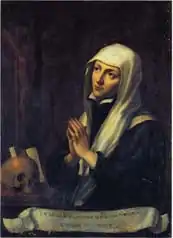Ursula Benincasa
Ursula Benincasa, (Italian: Orsola Benincasa), born October 21, 1547 or 1551[1]and died in Naples on October 20, 1618, was an Italian nun and mystic, declared venerable, founder of the Oblate Sisters and Hermitage of the Contemplative Sisters of the Immaculate Conception, later the Theatine Sisters of the Immaculate Conception of the Virgin Mary.[2]

Life
Ursula Benincasa was born into a religious family related to Catherine of Siena, who bore the same family name.
With great religious fervor, the young Ursula tried to enter the Capuchin Poor Clares of the monastery of Santa Maria di Gerusalemme, but was not accepted because of her too young age. Around 1576, she retired to a hermitage near the Castel Sant'Elmo in the Vomero district. She quickly acquired a reputation for holiness and attracted many followers. During an ecstasy, she was ordered to build a church, completed in 1582.
Following a mystical experience, she was received in audience on May 3, 1582 in Frascati by Pope Gregory XIII to whom she explained that God had instructed her to ask the pontiff to reform the entire Catholic Church. As a result, she was subjected to rigorous examinations by a commission which included Cardinal Giulio Antonio Santorio, then Grand Inquisitor in Rome, and Philippe Néri, founder of the Congregation of the Oratory. The commission recognized her religious virtues and she was able to return to Naples, with an authorization to found a religious community.
In 1584, she founded the Oblate Sisters of the Immaculate Conception of the Virgin Mary (Italian: Oblate della SS. Concezione di Maria) next to her church, whose members devoted themselves to the education of youth, especially of the girls.
In 1616 or 1617, Ursula Benincasa had a vision of the Virgin Mary and the baby Jesus. This vision is at the origin of the Blue Scapular of the Immaculate Conception and the foundation of the Hermitage of the Contemplative Sisters of the Immaculate Conception.[3] The rule was that of an ascetic life devoted to contemplative prayer to support the apostolic work of the Oblates.
In 1617, Benincasa had the revelation that his community was to join the Theatin Order, which was authorized by Pope Urban VIII in 1633.
After her death, a large monastic complex was built around the first buildings. After the Italian unification, a free girls' school opened there. Since 2004, this complex has been the seat of the Suor Orsola Benincasa University of Naples.
On August 7, 1793, her religious virtues were recognized by Pope Pius VI, who declared her venerable.
See also
References
- The sources differ on year and place of birth
- "BENINCASA, Orsola in "Dizionario Biografico"". www.treccani.it (in Italian). Retrieved 2018-04-22.
- Le scapulaire de l'Immaculée Conception de la sainte Vierge Marie, en l'église de Saint-Augustin [à Anvers] (in French). Parys. 1854.
Bibliography
- Silvana Menchi: Dizionario Biografico degli Italiani - Volume 8 (1966), dans l'Encyclopédie Treccani.
- Vittoria Fiorelli, Una santa della città : suor Orsola Benincasa e la devozione napoletana tra Cinquecento e Seicento, Naples, Editoriale scientifica, séries Series: Historica (Istituto universitario di magistero "Suor Orsola Benincasa"), 2001.